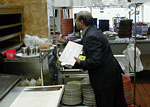Too Many Enforcers, Too Little Enforcement
By Jae Bryson
March 16, 2001
The safety of the food you eat in restaurants is generally considered very high. Minnesota has a strong reputation for tracking down the causes of foodborne illnesses. But some are concerned about the patchwork approach to restaurant inspection, especially in the Twin Cities area - where some 17 city and county agencies have that responsibility. Alhough they are working with the same document, the Minnesota Uniform Food Code, the results produced by these 17 agencies are wildly disparate. This fall, the Department of Health plans to standardize inspections across the state in an effort to improve food safety.
| |
|
|
|
||
"If you looked at a map of the U.S. you would think, 'Don't eat the food in Minnesota,'" Feirtag says.
But, Feirtag says, the real issue is not the number of outbreaks. The main issue, she says, is the changing strategy of inspection, which emphasizes education over enforcement. Critics like Feirtag say too much education, and too little enforcement, puts Minnesotans at risk.
"You can have all the great regulations on the books. But, if you don't enforce them and if there's no accountability for putting these rules into place, they really aren't worth the paper they're printed on," says Feirtag.
INSPECTIONS VARY FROM CITY TO CITY
The state health department hopes to improve food safety, and at the same time, counteract the perception of weak inspections, by standardizing both the state food code and the inspection process. One of its biggest challenges will be in the Twin Cities area. A patchwork of 17 city, county and state agencies inspect Twin Cities restaurants, and inspection results vary widely between them. For example, Minneapolis inspectors shut down 17 restaurants last year for food safety violations, while in St. Paul, inspectors did not close any.
|
"We in the health department find it very frustrating that we have to
educate people to wash their hands. Or, to separate raw meat from ready-to-eat
foods so there is no cross-contamination."
- Joe Hibberd, Ramsey County Health Department |
But Bob Kessler, former head of the city of St. Paul's Inspections Department, argues that education is a better long-term solution.
"We think the emphasis should always be on education and follow-up on the part of our inspectors. Just because you close restaurants involuntarily doesn't mean you have a good inspection program," says Kessler.
Sebastian Cherayil, a restaurant inspector for the Minneapolis Environmental Health Division, works on the front lines of food inspection. On this day, he is inspecting the Chicago Deli on Chicago Ave. in Minneapolis. It is late in the lunch hour.
Cherayil busies himself piercing potatoes with his thermometer and peering up at cheesecake with his flashlight. He is looking for what are called critical violations, things that can cause foodborne illness. For example, if hot foods are not kept above 150 degrees Fahrenheit, or cold foods kept below 41 degrees Fahrenheit, those are critical violations. Bacteria grow more quickly on foods held at the wrong temperature.
RELYING ON EDUCATION AND STANDARD ENFORCEMENT
Food inspection is trying to follow the lead that science has set. The Minnesota food code, which has been in effect for nearly three years, is strongly based on science. It requires less reliance on "floors and walls" inspections, which focused on the cleanliness of the environment. Now, most inspections focus on critical violations. In this new era of "education first," inspectors like Cherayil are more likely to work with restaurant owners who are found in violation, rather than close them down.
This fall, the Minnesota Health Department plans to standardize inspection processes across the state. While it remains to be seen how standardization will affect the future of restaurant inspection, many in the field say it can't hurt.
| |
|
|
|
||
"We in the health department find it very frustrating that we have to educate people to wash their hands. Or, to separate raw meat from ready-to-eat foods so there is no cross-contamination. I think the health departments are trying different approaches to find one magic way that will assure compliance and make the food safe," says Hibberd.
That is the real test of pro-education thinking: safer food. Science has determined safe temperatures and safe practices, such as encouraging food handlers who are sick to remain home. But, restaurant inspections have traditionally been based on the judgment of the inspectors. There are those who feel the new code does not incorporate those years of experience. Bloomington Environmental Health Department manager Petrona Lee is one of those who says the new code needs some fine tuning - despite its scientific focus.
"I think the food code has gotten less stringent. For example, the new food code allows the food to sit in an uncontrolled environment for up to four hours. We have a problem with that," says Lee.
The U of M's Joellen Feirtag says because of the many jurisdictions responsible for food inspections, the current process is inconsistent. She says she isn't sure the standardized inspections will change that, because there will be a natural resistance to change from some inspectors. Feirtag says one goal of the new program should be to change the attitudes of inspectors.
The new uniform restaurant inspection code takes effect this fall.
Related Links:
Minnesota Department of Agriculture
oversees food safety rules and regulations in Minnesota.
The American Society for Microbiology
explains the proper way to wash your hands.
Nation's Restaurant News
has articles about food safety efforts in restaurants.


